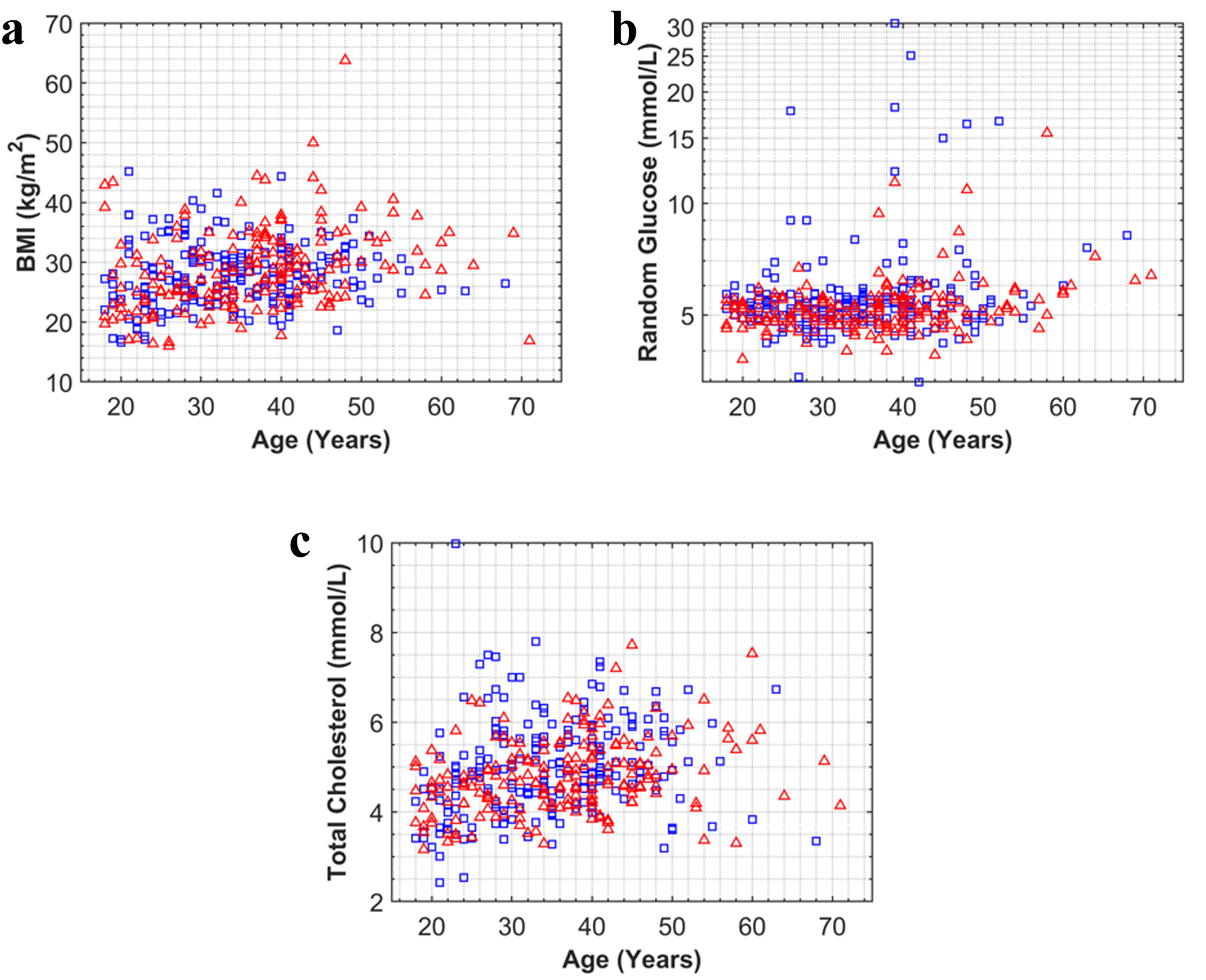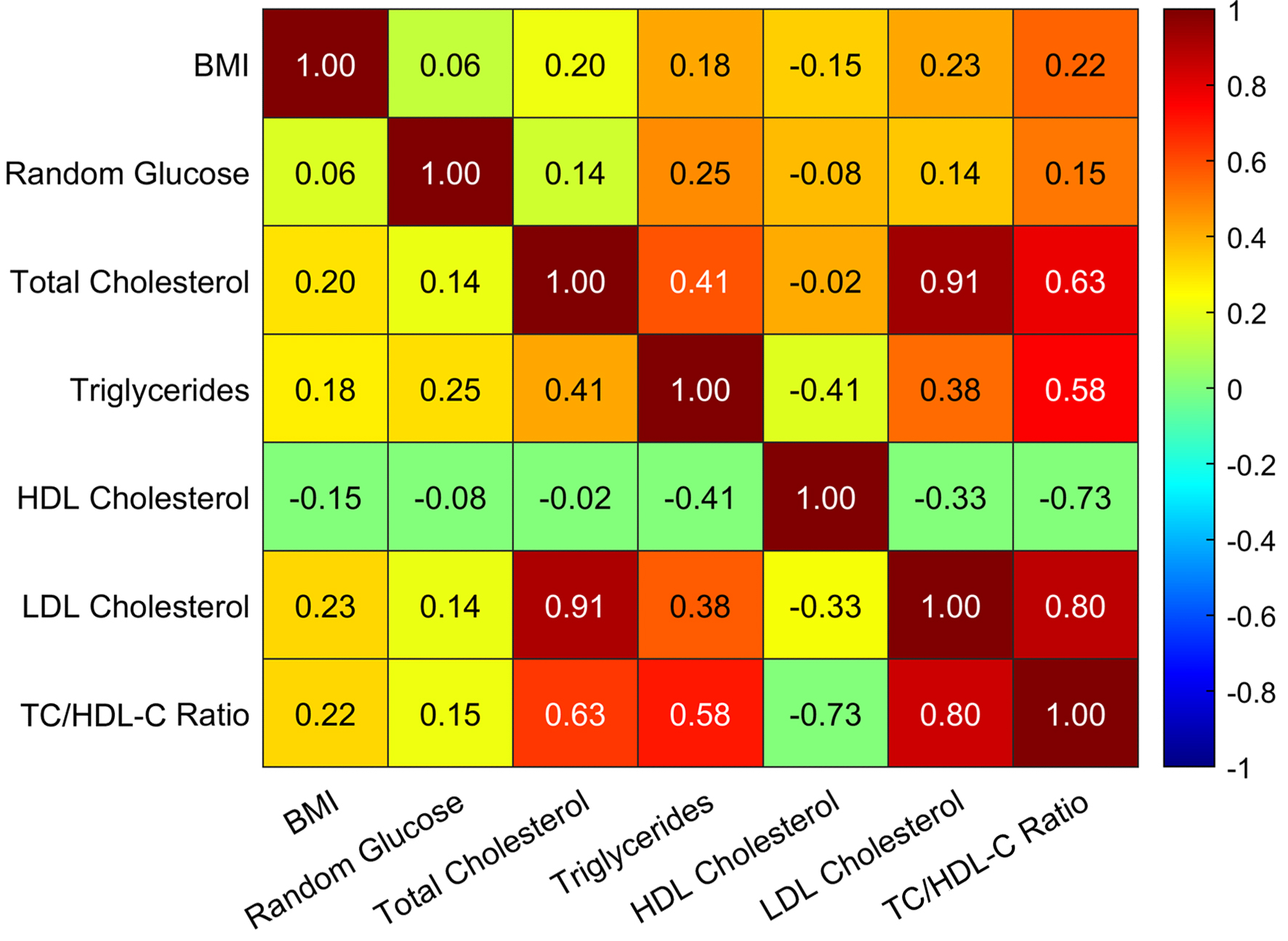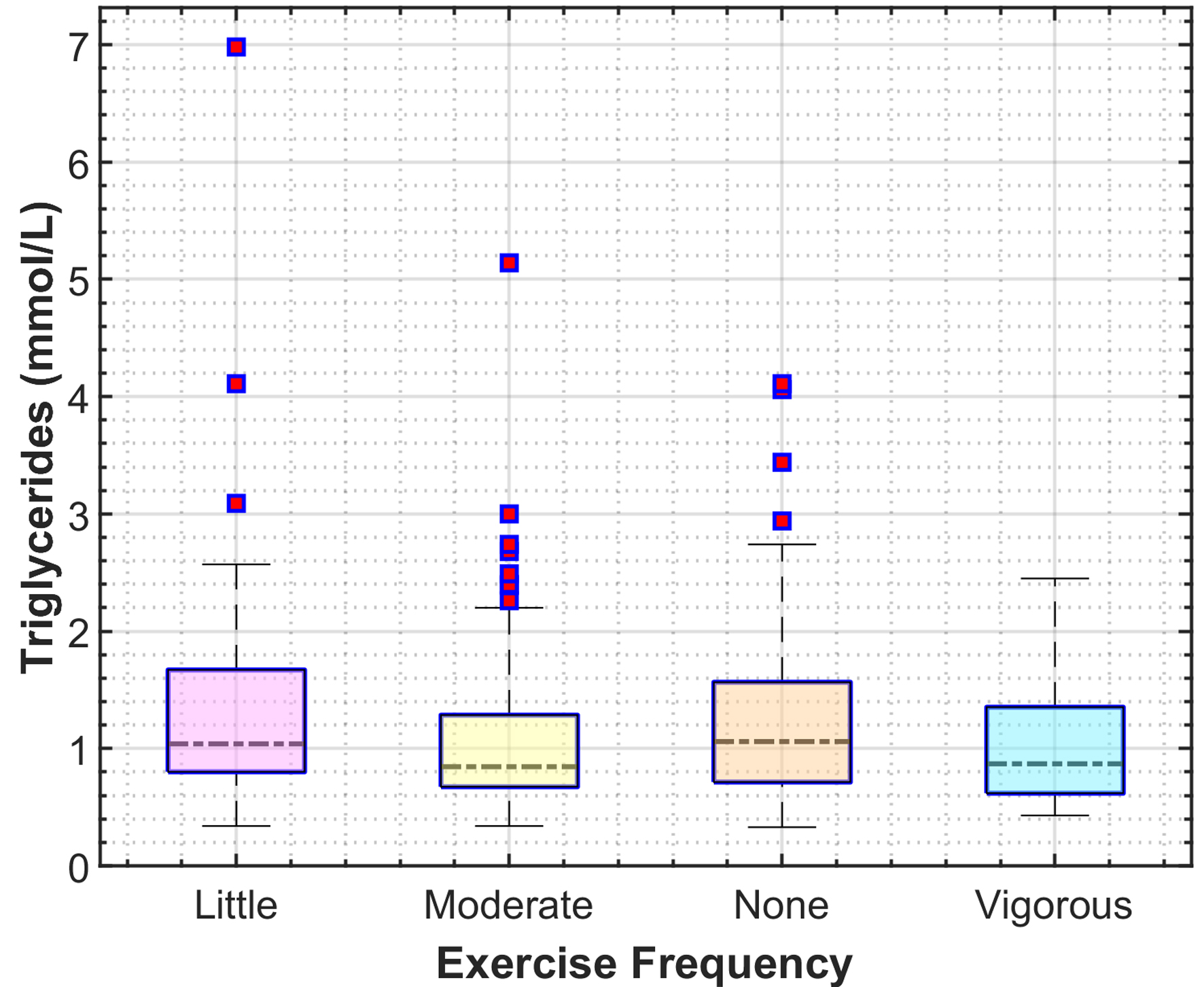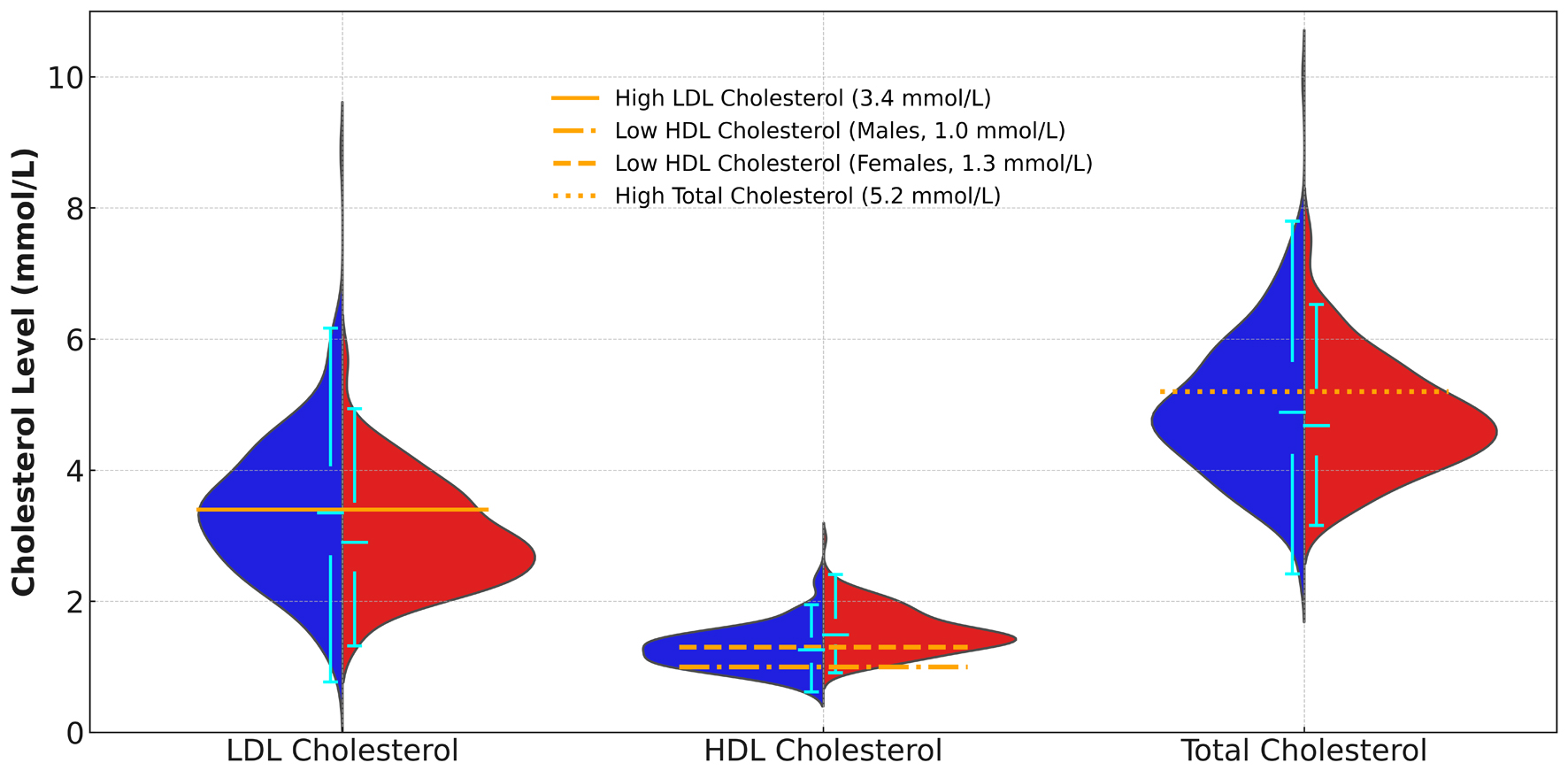
Figure 1. Scatter plots of age (years) versus (a) BMI (kg/m2), (b) random glucose (mmol/L), and (c) total cholesterol (mmol/L) by gender. Males are represented by “□” and females by “Δ”. BMI: body mass index.
| Journal of Endocrinology and Metabolism, ISSN 1923-2861 print, 1923-287X online, Open Access |
| Article copyright, the authors; Journal compilation copyright, J Endocrinol Metab and Elmer Press Inc |
| Journal website https://jem.elmerpub.com |
Original Article
Volume 15, Number 3, August 2025, pages 100-108
Dyslipidemia Prevalence and Risk Factors in Al Ain: A Retrospective Cross-Sectional Analysis
Figures




Table
| Total | Normal lipid profile | Abnormal lipid profile | P value | |
|---|---|---|---|---|
| “Total” percentages are based on the sample size (N = 398). Lipid profile percentages are calculated within each row category. BMI: body mass index; SD: standard deviation. | ||||
| Gender | ||||
| Female | 186 (46.7%) | 86 (46.2%) | 100 (53.8%) | < 0.001 |
| Male | 212 (53.3%) | 49 (23.1%) | 163 (76.9%) | |
| Age, mean (SD), years | 35 (10) | 32 (10) | 37 (10) | |
| Age group | ||||
| 18 - 29 years | 129 (32.4%) | 61 (45.2%) | 68 (25.9%) | < 0.001 |
| 30 - 39 years | 126 (31.7%) | 41 (30.4%) | 85 (32.3%) | |
| 40 - 49 years | 111 (27.9%) | 29 (21.5%) | 82 (31.2%) | |
| ≥ 50 years | 32 (8.0%) | 4 (3.0%) | 28 (10.6%) | |
| Education level | ||||
| Secondary education | 276 (69.3%) | 89 (65.9%) | 187 (71.1%) | 0.429 |
| Tertiary education | 102 (25.6%) | 37 (27.4%) | 65 (24.7%) | |
| Below secondary education | 20 (5.0%) | 9 (6.7%) | 11 (4.2%) | |
| Employment status | ||||
| Yes | 262 (65.8%) | 82 (60.7%) | 180 (68.4%) | 0.125 |
| No | 136 (34.2%) | 53 (39.3%) | 83 (31.6%) | |
| BMI, mean (SD), kg/m2 | 28.3 (6.0) | 26.3 (5.8) | 29.4 (5.8) | |
| Weight status | ||||
| Underweight (< 18.5 kg/m2) | 17 (4.3%) | 11 (8.1%) | 6 (2.3%) | < 0.001 |
| Normal weight (18.5 - 24.9 kg/m2) | 102 (25.6%) | 46 (34.1%) | 56 (21.3%) | |
| Overweight (25 - 29.9 kg/m2) | 138 (34.7%) | 46 (34.1%) | 92 (35.0%) | |
| Obesity (≥ 30 kg/m2) | 141 (35.4%) | 32 (23.7%) | 109 (41.4%) | |
| Physical activity | ||||
| None | 212 (53.3%) | 70 (51.9%) | 142 (54.0%) | 0.210 |
| Little | 51 (12.8%) | 12 (8.9%) | 39 (14.8%) | |
| Moderate | 96 (24.1%) | 39 (28.9%) | 57 (21.7%) | |
| Vigorous | 39 (9.8%) | 14 (10.4%) | 25 (9.5%) | |
| Smoking | ||||
| No | 316 (79.4%) | 120 (88.9%) | 196 (74.5%) | < 0.001 |
| Yes | 82 (20.6%) | 15 (11.1%) | 67 (25.5%) | |
| Hypertension | ||||
| No | 380 (95.5%) | 132 (97.8%) | 248 (94.3%) | 0.114 |
| Yes | 18 (4.5%) | 3 (2.2%) | 15 (5.7%) | |
| Diabetes | ||||
| No | 372 (93.5%) | 130 (96.3%) | 242 (92.0%) | 0.102 |
| Yes | 26 (6.5%) | 5 (3.7%) | 21 (8.0%) | |
| Cardiovascular diseases | ||||
| No | 393 (98.7%) | 133 (98.5%) | 260 (98.9%) | 0.773 |
| Yes | 5 (1.3%) | 2 (1.5%) | 3 (1.1%) | |
| Family history of hypertension | ||||
| No | 218 (54.8%) | 80 (59.3%) | 138 (52.5%) | 0.198 |
| Yes | 180 (45.2%) | 55 (40.7%) | 125 (47.5%) | |
| Family history of diabetes | ||||
| No | 196 (49.2%) | 65 (48.1%) | 131 (49.8%) | 0.754 |
| Yes | 202 (50.8%) | 70 (51.9%) | 132 (50.2%) | |
| Family history of cardiovascular diseases | ||||
| No | 358 (89.9%) | 126 (93.3%) | 232 (88.2%) | 0.108 |
| Yes | 40 (10.1%) | 9 (6.7%) | 31 (11.8%) | |